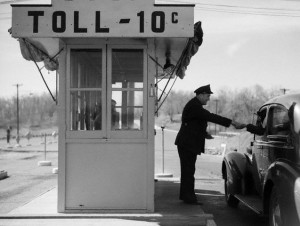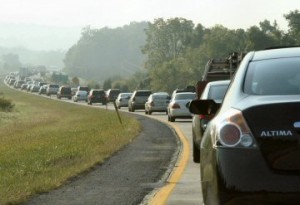The ‘To Toll or Not to Toll’ discussion continues . . . the tolling of 422  continues to make headlines and yesterday was a busy day for legislators on either side of the issue.
continues to make headlines and yesterday was a busy day for legislators on either side of the issue.
In an op-ed article (6/9/11) in the Philadelphia Inquirer, Joe Hoeffel (D), vice chair of the Montgomery County Commission and chair of the Delaware Valley Regional Planning Commission, wrote, “there isn’t enough state or federal money for the job. The state has budgeted $250 million for the Route 422 corridor over the next decade, but transportation experts agree that $750 million is needed. And nobody believes the legislature or Congress will provide that kind of funding anytime soon. Without a new funding source, 422 will not be fixed for at least 30 years, according to projections by the state Department of Transportation. By that time, the highway will be gridlocked for much of the day.” Hoeffel supports tolling of 422 and believes that a modest toll could generate $800 million in a few years.
Opposing the tolling of 422, state representatives David Maloney, (R) Berks, Marcy Toepel, (R) Montgomery, Tom Quigley, (R) Montgomery and Warren Kampf (R), our 157th district representative, held a news conference in Phoenixville yesterday. Calling the 422 project, the Hoeffel Tolling Plan, these local legislators do not believe that tolling is a viable option to pay for infrastructure improvements. Click here for a short video clip of the press conference.
There continues to be much written and discussed about the tolling of 422. Depending on how you feel about the topic, you can find supporters on either side of the issue; those for tolling and those against tolling. However, regardless of your personal views on tolling, I think we can all agree that the traffic congestion on 422 is a commuter’s nightmare and that something needs to change, and. . . we need people with a vision to encourage that change.
We aware that our own state representative continues to stand behind his ‘no tolling of 422′ campaign message — but it was unclear to me whether Kampf considered that Route 422 was actually a traffic problem. Seeking clarification on his ‘422 traffic’ position, I sent him this simple email a couple of days ago:
Dear Rep. Kampf,
As my elected State Representative, do you believe that there is a traffic problem on Route 422?
Thank you and I look forward to your response.
Pattye Benson
As some of you are aware, my previous communication with Kampf has not always been the most successful. Now that he is our elected state representative, I was curious to see if anything had changed and admit I was pleasantly surprised that he took the time to send a personal and lengthy response. I believe that there is value in my sharing his response and have notified him that I would be adding it to today’s post on Community Matters. His reply to my email:
Pattye:
Thank you for your email. I welcome the opportunity to respond.
As you may have heard, I am on record as being against tolling 422. I believe that this “toll” is just another name for a tax on the already overburdened commuters of that roadway. But I recognize that 422 is a transportation problem for commuters.
The idea to address 422’s needs without tolling is not solely mine; Governor Corbett has convened a Transportation Funding Advisory Committee that is looking at over 50 prospective ways to address the funding gap for our road/bridge infrastructure (tolling is one of the options but in no way is it the only option being discussed). I believe that prioritizing, finding cost savings and advocacy for our regional roadways must be tools considered as part of the discussion too.
I have empathy for the people who drive that roadway, and I have my own personal experience on 422 to draw from. We all pay the same gas taxes and vehicle fees that others in Pennsylvania pay, but the response to fix our road has been to ask my constituents to pay up to $5 a day more for the privilege of driving that road! That just seems unfair.
Other areas have had road and bridge needs addressed. PennDOT does have a larger plan for the area’s roads. As you know, 202 is getting significant improvement. Route 309 was also rebuilt. These projects came to fruition not with tolling revenue but with the already existing sources within the Commonwealth that I mentioned above. Why is 422 unique?
There is over $240 Million currently programmed for improvement of 422 during the next eight (8) years within the PennDOT plans. This is in the plan without tolling. While it is not enough, and does not come fast enough, it will be a good start. Tolling does not appear likely to make this set of improvements happen any faster that I can tell. Further, this proposal is being billed as a public private partnership, but fundamentally it is almost entirely public money—both tolls and other transportation funding—that will pay for these improvements. Finally, there is a rail line proposal in the mix here, paid for with toll money. While I certainly recognize the attractiveness of restored rail to towns like Phoenixville, this will in all likelihood require management by SEPTA, or some such entity, and we know such rail lines usually run at a significant deficit year in and year out. That cost will ultimately pass on to the taxpayers, and I campaigned on a platform that promised the taxpayer, in tough times such as these and in good times, a seat at the table when these decisions are made. I feel I am making good on that commitment but seeking alternatives.
As a final thought, we built 422 with public money. We have maintained it with public money. We have continued to collect those monies and have an obligation to serve the people who drive that road. One could argue it would be a violation of the public trust to change the game now and introduce tolls. The 422 corridor continues to grow in large part because of the access that road provides. Indeed, it is a road regularly used for shopping and other trips not related to “commuting.” I believe my constituents feel as I do, and I welcome your input.
Thank you for your question.
Warren

